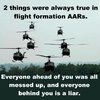Maybe I need to clarify not “formation” but flying together to same destination?

Both planes can launch...in time...quite closely. When the first is off give them time to climb out safely. Then you can launch. Here you will see the first irony...if both planes are relatively similar in speeds it will seem like it takes miles to even catch up to race other.
Definitely use 122.75 and not some made up one like 123.45, etc. But if your flight is short or you'll both be on flight following you'll find it hard to also be using 122.75 since you will also be using a second com for ATIS, etc.
If you are both on flight following one of you, ideally the second can also tell them about the first and you have the same destination but not a "Flight of 2". ATC will most likely advise you to maintain visual contact...or they do around here.
We like to agree on slightly staggered altitudes with the first a bit higher because it is like 1000x easier to see the guy ahead of you when hes above the horizon.
Our groups are at most 8 planes, not formation but same launch time and destination for events. We just always pass well to the side and tell the person being overtaken. We like to keep minimum distance when passing to about 1000ft. Good enough for some pictures but lots of room to wiggle.
We tried the slowest guy first but when these aren't true formations it doesnt work. Our resident 414 will launch last and always overtake. No way hes gonna mush at slower speeds. Then a Dakota and our 182 usually overtake the 172/150/Cherokee180 and slower planes. So the irony is we launch the slowest planes first.
Up to this part I haven't found anything that stressful. But no one actually talks that much on 122.75 which I thought would get used more.
The only stressful time we ran into was a airport with no taxiway and a long post landing back taxi. The first three of us managed to stagger our arrivals but all the slower planes arrived too close together so it was actually worse than a fly in with several planes doing pattern laps to get a landing cycle in.
Have fun. It's really cool to fly with other planes. Just talk it out first and in the end it's really just you PIC.
I wouldn't advise close formation flying.






